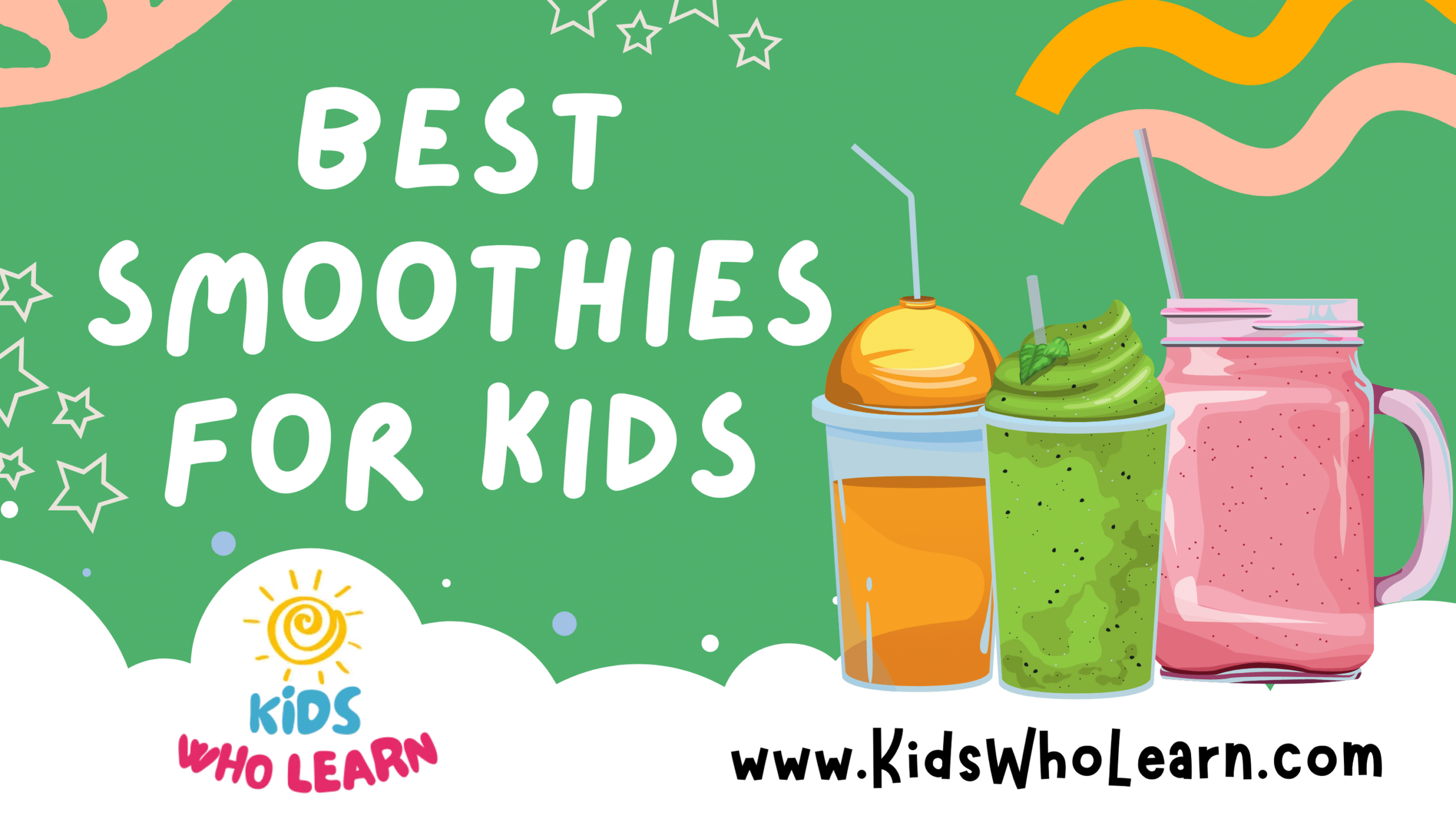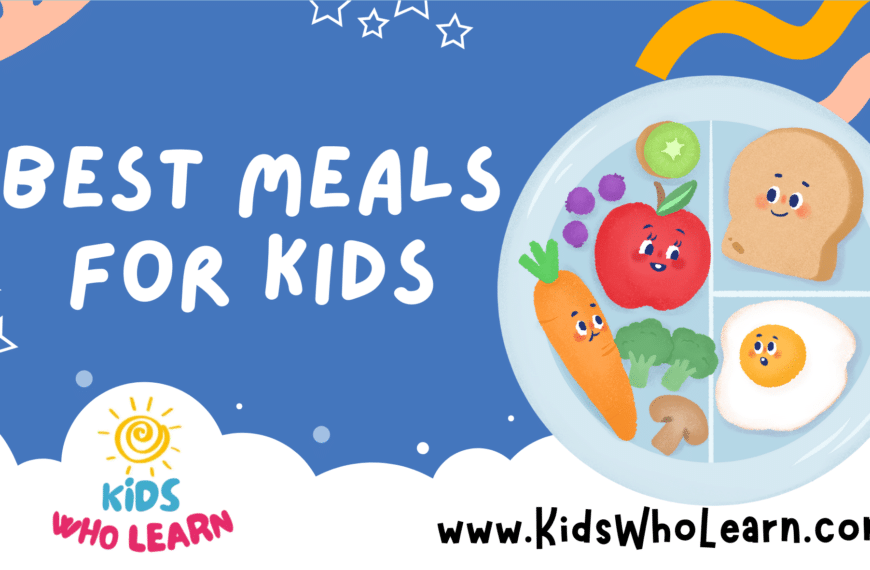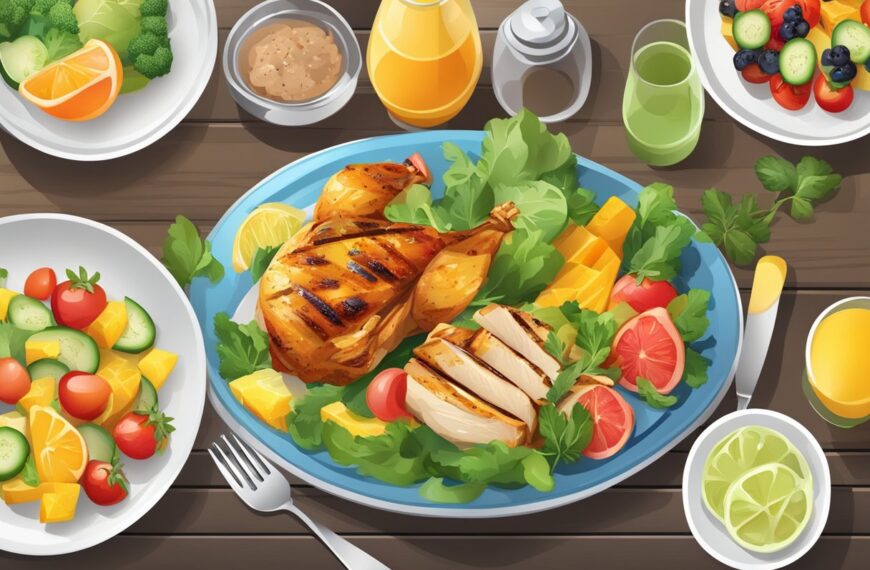Smoothies can be a delightful and nutritious option for kids, offering a variety of flavors and health benefits in a convenient, drinkable form. They are a smart way to ensure your children get their daily servings of fruits and vegetables, particularly if you have picky eaters. Incorporating the right ingredients into smoothies can help bolster their nutritional profile, supplying essential vitamins, minerals, and other nutrients important for growing bodies.
The key to a kid-friendly smoothie is making sure it’s both healthy and appealing to their taste buds. Balancing the sweetness kids crave with the nutritional content they need doesn’t have to be difficult. You can achieve this by selecting the right combination of fruits, vegetables, and other wholesome ingredients. Keep in mind that the best smoothies for kids have smooth textures and flavors they love, making it easier for them to enjoy their drinks without a fuss.
Safety and cleanliness in preparing smoothies are of utmost importance, just as considering any potential allergies or dietary restrictions. By being creative and involving children in the smoothie-making process, you can make it an engaging activity that teaches them about healthy eating habits. Choosing seasonal ingredients also promotes sustainability and ensures that the smoothies are made with the freshest produce available.
Key Takeaways
- Smoothies provide an enjoyable way to increase kids’ intake of fruits and veggies.
- Balance in taste and nutrition is essential for kid-approved smoothies.
- Involvement in smoothie preparation can foster healthy eating habits in children.
Benefits of Choosing the Right Smoothies for Kids
Choosing the right smoothies can provide numerous health benefits for your children. A well-crafted smoothie can be an excellent source of essential vitamins and minerals, helping to ensure that your kids get the nutrients they need for healthy growth and development.
When selecting ingredients, consider fruits high in vitamin C and antioxidants, such as oranges or berries. These boost the immune system and protect against illnesses. Including leafy greens like spinach can also add fiber, which aids in maintaining a healthy digestive system.
Protein is another crucial component often included in smoothies through yogurt or milk, which are also good sources of calcium, key for bone strength. For children who are lactose intolerant or following a plant-based diet, almond or soy milk are great alternatives, offering both protein and calcium.
Here is a snapshot of the nutritional elements and their roles:
| Nutrient | Role in Health |
|---|---|
| Vitamins | Immune support, cell growth, and repair |
| Antioxidants | Protect cells from damage |
| Fiber | Digestive health |
| Protein | Muscle growth and repair |
| Omega-3 Fatty Acids | Brain health and development |
| Calcium | Bone strength |
| Magnesium | Over 300 biochemical reactions in the body |
In addition to the physical benefits, these nutrients play a vital role in brain health. Omega-3 fatty acids, found in ingredients like flax seeds or walnuts, are particularly important for brain function and can be easily incorporated into smoothies.
Remember, the key is balance. Ensure your smoothies have a mix of fruits, vegetables, protein sources, and healthy fats to maximize the benefits for your kids.
Essential Ingredients for Kid-Friendly Smoothies
When creating smoothies for kids, it’s important to balance nutrition with flavors that they enjoy. Starting with fruits, bananas are a staple for sweetness and creamy texture, while blueberries add a burst of flavor and antioxidants. Peaches bring in a mellow sweetness that pairs well with other fruits.
In terms of vegetables, incorporating greens like spinach and kale can boost the nutrient content without overwhelming the taste. Avocado is an excellent addition for healthy fats and a creamy consistency. For a subtle zing and digestive benefits, a small amount of ginger goes a long way.
To smooth out your smoothie and add a protein punch, consider using yogurt or greek yogurt. For a dairy-free option, almond milk is a great alternative, providing a mild nutty flavor and a liquid base for blending.
Including seeds such as chia adds omega-3s and fiber. Nuts, like a spoonful of almond butter or a handful of cashews, contribute healthy fats and make the smoothie more satisfying.
Finally, for added sweetness without using refined sugars, a drizzle of honey can be used. If you’re crafting a chocolate smoothie, cocoa powder can provide a rich flavor beloved by many kids.
Below is a quick guide to these ingredients:
| Category | Ingredients | Benefits |
|---|---|---|
| Fruits | Banana, Blueberry, Peach | Natural sweetness, vitamins, antioxidants |
| Veggies | Kale, Spinach, Avocado, Ginger | Fiber, vitamins, healthy fats |
| Dairy | Yogurt, Greek Yogurt | Calcium, protein |
| Non-Dairy Alternatives | Almond Milk | Vitamins, lighter texture |
| Seeds/Nuts | Chia Seeds, Almond Butter, Cashews | Omega-3s, fiber, healthy fats |
| Sweeteners | Honey | Natural sweetness |
| Flavor Additions | Cocoa Powder | Antioxidants, rich flavor |
By combining these ingredients, you can create a delicious and healthy smoothie that is sure to be a hit with the kids.
Top Smoothie Recipes for Kids
Crafting nutritious and delicious smoothies for your little ones can be both fun and simple. With a variety of flavors and textures, these recipes are designed to be kid-friendly while incorporating healthy ingredients.
Chocolate Banana Smoothie
Blend together 1 ripe banana, 2 tablespoons of cocoa powder, and 1 cup of milk for a creamy and rich chocolate banana delight. Perfect for kids who love a thick, chocolatey treat.
Berry Burst Breakfast Smoothie
Mix 1/2 cup of strawberries, 1/4 cup of blueberries, and 1 banana with 1/2 cup of your choice of fruit juice for a berry-rich smoothie. This provides a fruity and refreshing start to the day.
Tropical Green Delight
Create a tropical fusion with 1/2 cup pineapple, 1 banana, and a handful of baby spinach for an introduction to green smoothies. Add 1 cup of orange juice to mask the veggie flavor while keeping it nutritious.
Creamy Dreamy Orange Smoothie
Combine 1 peeled orange, 1/2 cup of frozen peaches, and 1 teaspoon of vanilla extract with 1 cup of milk for a smoothie that tastes like a healthy orange creamsicle.
Peanut Butter Bliss
For a protein boost, blend 2 tablespoons of peanut butter with 1 banana and 1 cup of milk. It’s like a chocolate peanut butter banana smoothie without the cocoa, focusing on the nutty flavor kids enjoy.
Sweet Peach Perfection
A simple peach smoothie requires 1 cup of frozen peaches, 1 teaspoon of vanilla extract, and 1 cup of milk. It’s a smoothie that emphasizes the natural sweetness of peaches with a hint of vanilla.
Very Vanilla Spinach Smoothie
Introduce more greens with 1 cup of baby spinach, 1 ripe banana, and 1 teaspoon of vanilla extract blended with 1 cup of milk. It’s a green smoothie with a sweet vanilla flavor.
Velvety Chocolate Almond
For those who like a nuttier chocolate taste, mix 2 tablespoons almond butter with 1 ripe banana, 2 tablespoons of cocoa powder, and 1 cup of milk.
Zesty Lemon and Blueberry Fusion
Brighten your day with the zest of 1 lemon (juice and zest), 1/2 cup of blueberries, and 1 banana along with 1 cup of water for a light and invigorating smoothie.
Cooling Mint and Watermelon Wave
Blend 1 cup of watermelon chunks with a few leaves of fresh mint and 1 cup of water for a refreshing, hydrating option that’s perfect for hot days.
Gingery Pear and Spinach Adventure
For a zingy taste, combine 1 ripe pear, a small piece of ginger (to taste), and 1 cup of baby spinach with 1 cup of water. This gives a surprising twist with the warmth of ginger.
Supreme Veggie Surprise
Mix stealthy veggies like cauliflower rice or chopped zucchini with your kids’ favorite fruits and 1 cup of their preferred milk for a sneaky but healthy smoothie.
Remember to adjust the consistency of your smoothies with more or less liquid to suit your child’s preference. Happy blending!
Optimizing Smoothie Texture and Flavor
To achieve the perfect thick texture in your smoothies, akin to a milkshake, focus on your choice of ingredients and blending technique. Using a high-powered blender is key to breaking down ingredients for a silky smooth consistency.
Thickening Agents:
- Oats: Add old-fashioned oats to introduce a creamy thickness without overpowering flavor.
- Flax Seeds: Ground flax not only contributes essential nutrients but also helps thicken your smoothie.
Technique:
- Start blending on low speed, gradually increasing to high. This approach creates a vortex, thoroughly combining ingredients without leaving chunks.
Texture Tips:
- For a denser texture, similar to ice cream, freeze your fruits ahead of time or use frozen fruits from the store.
- If the smoothie is too thick, adjust by adding small amounts of liquid until desired consistency is reached.
Flavor Enhancement:
- Balance sweet fruits with milder ingredients to prevent flavor dominance.
- Incorporate a pinch of salt to heighten the overall taste profile of your smoothie.
Remember, the quality of your smoothie heavily relies on the freshness of ingredients, so prioritize ripe and in-season produce for optimal flavor.
Healthy Add-Ins and Substitutions
When preparing smoothies for kids, it’s important to boost nutritional value without compromising taste. Chia seeds and flax seeds are excellent sources of omega-3 fatty acids and fiber. Just a tablespoon can enrich your smoothie with essential nutrients.
For a natural sweetener alternative to sugar, consider using honey. It not only adds sweetness but also brings in its unique flavor profile. Be mindful of the quantity to maintain a balance in taste and health.
| Nutrient Booster | Recommended Amount |
|---|---|
| Chia Seeds | 1 tablespoon |
| Flax Seeds | 1 tablespoon |
| Honey | 1-2 teaspoons |
Swapping in Greek yogurt for regular yogurt increases the smoothie’s protein content, providing a creamier texture and a tangy kick that kids love. It’s a perfect way to enhance satiety and aid in your child’s growth and muscle development.
Introducing cocoa powder offers a chocolatey flavor without the excess sugars found in chocolate syrups. It contains antioxidants and can make a smoothie more appealing to children.
Incorporate peanut butter or almond butter for a satisfying dose of healthy fats and proteins. These nut butters also contribute to a richer, more indulgent smoothie experience.
- Cinnamon and vanilla extract are flavorful spice additions that can add a comforting aroma and taste, all while being low in calories.
Blueberries and bananas are fruits rich in vitamins and nutrients, making them perfect for increasing the natural sweetness and fiber content of smoothies.
Lastly, consider the term superfood as a way to describe ingredients like chia seeds and blueberries, which are dense in nutrients and beneficial to health. Incorporate a variety of these superfoods to ensure your smoothies are both delicious and wholesome.
Smoothie-Making Tips for Busy Mornings
During busy mornings, you need smoothie recipes that are quick and easy to make, ensuring your kids get a nutritious start to the day. Time is of the essence, so consider these tips to streamline your routine.
Prep the Night Before: Chop fruits and vegetables and store them in zip-lock bags in the freezer. Your prep work upfront makes the morning blending a breeze.
Use the Right Blender: Invest in a high-quality blender that can handle frozen ingredients and operate quickly. This will save you time and give you a smoother consistency.
Simple Recipes Work Best: Stick to recipes with fewer ingredients. A basic smoothie can be as simple as banana, spinach, and almond milk. Fewer ingredients mean faster preparation.
Quick Mix-And-Match Chart
| Base | Fruit | Vegetable | Protein | Liquid |
|---|---|---|---|---|
| Banana | Berries | Spinach | Greek Yogurt | Almond Milk |
| Greek Yogurt | Apple | Kale | Protein Powder | Coconut Milk |
| Avocado | Peach | Carrot | Nut Butter | Oat Milk |
Make Cleanup Fast: Always rinse your blender immediately after use. Less time scrubbing means more time for you.
Essential Ingredients to Keep Stocked
- Fruits: Bananas, berries, and apples.
- Vegetables: Spinach and kale.
- Proteins: Greek yogurt and nut butters.
- Liquids: Almond milk, coconut milk, or oat milk.
By following these tips, you can make smoothies for your kids that are not only nutritious but also quick and easy, even on the busiest of mornings.
Allergies and Dietary Restrictions
When preparing smoothies for children with allergies or dietary restrictions, it’s crucial to carefully select ingredients that cater to their needs while ensuring the smoothie remains nutritious and delicious.
Dairy-Free Alternatives
To replace dairy milk in your child’s smoothie, almond milk or soy milk are excellent choices offering a creamy texture. Non-dairy yogurt can also be added to achieve a similar consistency to traditional smoothies.
- Almond Milk: A flavorful and nutritious alternative, low in calories.
- Soy Milk: Rich in protein and fortified with vitamins, similar to cow’s milk.
Gluten-Free Oats and Grains
For children sensitive to gluten, old-fashioned oats are a safe grain option, provided they are labeled gluten-free, ensuring no cross-contamination.
- Old-Fashioned Oats: Add fiber and texture, certified gluten-free oats are safe for those with celiac disease or gluten sensitivity.
Nut-Free Options
For those allergic to nuts, using sunflower seed butter is a tasty and safe way to incorporate creaminess and protein into smoothies without the risk of allergic reactions.
- Sunflower Seed Butter: A nut-free alternative that provides a rich, creamy texture.
Using Natural Sweeteners
Avoid processed sugars by opting for natural sweeteners like agave or honey for children above one year of age, or use natural fruit juice to sweeten the smoothie.
- Agave: A plant-based sweetener that is sweeter than sugar, so you’ll need less.
- Honey: Naturally sweet and loaded with antioxidants, but only recommended for children over 12 months old.
Vegan-Friendly Smoothie Twists
To cater to vegan dietary restrictions, replace any animal-derived ingredients with plant-based ones such as non-dairy yogurt or tofu to maintain smoothness and add protein.
- Non-dairy Yogurt: Adds creaminess without dairy and comes in various flavors.
- Tofu: An excellent source of protein and nutrients, blending well without affecting the taste.
Soy and Egg Substitutes
For children who are allergic to eggs or soy, incorporating an egg replacer or avoiding soy-based products like tofu and soy milk can help create a safe, allergen-free smoothie.
- Egg Replacer: Use it to add thickness to smoothies without using eggs.
- Avoid using soy products if your child has a soy allergy; instead, opt for the mentioned alternatives.
Understanding Nutritional Values
When choosing smoothies for kids, understanding the nutritional values is essential. Nutritional values are typically broken down into calories, macronutrients, and micronutrients.
Calories provide energy, but it’s important to balance the intake to support a child’s growth without leading to excess weight gain. Aim for smoothies that are satisfying but not overly high in calories.
Macronutrients include:
- Proteins: Essential for growth and repair of tissues.
- Carbohydrates: The primary energy source, including fibers which are important for digestion.
- Fats: Necessary for brain development, especially omega-3, 6, and 9 fatty acids.
Smoothies can be a delicious way to incorporate a balance of these macronutrients into your child’s diet.
Micronutrients are vitamins and minerals required in smaller quantities but are crucial for proper body functioning. Key micronutrients to look for in smoothies are:
- Vitamins such as Vitamin C, vital for immunity, and B Vitamins for energy metabolism.
- Minerals like potassium, which helps in muscle functions and maintaining healthy blood pressure levels.
Here is a simple breakdown of important micronutrients to include:
| Vitamin/Mineral | Role | Suggested Source |
|---|---|---|
| Vitamin C | Immune function, skin health | Oranges, strawberries |
| Vitamin K | Blood clotting, bone health | Spinach, kale |
| Vitamin B | Energy production, nervous system health | Nuts, seeds, bananas |
| Potassium | Muscle functions, fluid balance | Bananas, spinach |
Remember to look for smoothies that use whole fruits and vegetables to ensure your child gets the fiber they need alongside these nutrients.
Engaging Kids with Smoothie Creations
Creating smoothies is a fun and interactive way to involve children in the kitchen. When you make the process kid-friendly, it becomes an opportunity for learning and experimentation. Here are some tips to get your children excited about making their own smoothies:
Experiment with Colors
Encourage your kids to create a rainbow of colors with their smoothies. Use a variety of fruits and vegetables like strawberries, blueberries, spinach, and carrots. You can create a chart like this to track your colorful creations:
| Color | Fruit/Vegetable Options |
|---|---|
| Red | Strawberries, Raspberries |
| Green | Spinach, Kiwi |
| Yellow | Bananas, Mango |
| Purple | Blueberries, Blackberries |
| Orange | Carrots, Oranges |
Name Your Smoothie
Allow your kids to come up with creative names for their smoothie concoctions. This makes them more invested in their creation and adds an element of play.
Simple Recipes for Starters
Begin with simple recipes that require just a few ingredients. Here’s a quick recipe to get you started:
- 1 banana
- 1/2 cup of strawberries
- 1 cup of milk or a milk alternative
- Ice cubes
Blend until smooth.
Involve Them in the Process
Give your children specific tasks such as peeling bananas, adding ingredients to the blender, or pressing the blend button. This hands-on approach is great for building their confidence in the kitchen.
Remember, the key is to keep the atmosphere light and enjoyable. By involving your children in the smoothie-making process, they’re learning valuable skills and developing healthy habits in a joyful way.
Safety Precautions and Hygiene
When preparing smoothies for kids, prioritize safety and hygiene to protect their health. Start by thoroughly washing your hands with soap and warm water for at least 20 seconds. Clear counter space and use sanitized cutting boards and blenders.
Inspection of Ingredients:
- Fresh Fruits/Vegetables: Ensure they are free from bruises or mold.
- Dairy or Plant-Based Milks: Confirm they are within the expiration date.
Clean Equipment:
- Blender: Rinse after each use; deep clean regularly.
- Utensils: Use dish soap and hot water to wash and air-dry utensils before use.
Prep Safety:
- Cutting: Use a stable surface; keep fingers clear of blades.
- Allergens: Be aware of food sensitivities; avoid cross-contamination.
Smoothie Storage:
| Temperature | Storage Duration |
|---|---|
| Refrigeration (4°C) | Up to 24 hours |
| Freezer (-18°C) | 1-2 months |
Remember, never serve a smoothie that has been unrefrigerated for over two hours. For optimal freshness, consume immediately after blending. If using supplements or non-traditional ingredients, ensure they are age-appropriate and safe. Always supervise children while blending to prevent accidents. By adhering to these safety and hygiene practices, you’ll craft delicious and nutritious smoothies that are also safe for your kids.
Sustainability and Seasonal Choices
When selecting ingredients for your kids’ smoothies, think about sustainability and the benefits of choosing seasonal fruits and vegetables. Your choices can make a positive impact on the environment and local agriculture.
Buy Local
Support your community by purchasing local produce. This not only reduces transportation emissions but also helps in maintaining local biodiversity.
- Local Markets: Visit nearby farmers’ markets for fresh options.
- Community-Supported Agriculture: Join a CSA program for regular supplies of local produce.
Seasonal Produce
Opting for fruits and vegetables that are in season is more sustainable. This practice often ensures:
- Peak Flavor: Seasonal produce is fresher and tastes better.
- Better Nutrition: Produce is more nutrient-dense when it’s harvested at the right time.
| Season | Suggested Produce for Smoothies |
|---|---|
| Spring | Strawberries, Mangoes |
| Summer | Blueberries, Peaches |
| Fall | Apples, Pears |
| Winter | Bananas, Oranges |
Organic Options
Consider organic selections to reduce exposure to pesticides and support farming practices that are more environmentally friendly.
Environmental Footprint
Finally, be mindful about packaging to minimize waste. Encourage the use of reusable containers or bottles for your kids’ smoothies.
By being conscious of these factors, you not only create healthier options for your children but also contribute to a healthier planet.
Frequently Asked Questions
What are the best types of fruit for kids’ smoothies?
For kids, opt for fruits that are naturally sweet and widely enjoyed, such as bananas, strawberries, blueberries, and mangoes. These fruits are not only flavorful but also nutritious.
Can I use fruit juice in my child’s smoothie?
Absolutely, you can add fruit juice to smoothies, but moderation is key. Opt for 100% fruit juice with no added sugars and consider watering it down to lower the sugar content.
How can I make smoothies appealing to children?
Presentation is crucial. Use colorful fruits, and consider adding fun toppings like coconut shavings or a small amount of granola. Serve in an attractive glass or a cup with a fun straw.
Is dairy necessary in kids’ smoothies?
Dairy is not essential. If you avoid dairy, substitute with plant-based milk alternatives like almond, soy, or oat milk. These options can add creaminess and nutritional value.
Are smoothies good for children who are picky eaters?
Yes, smoothies can be an excellent way to include fruits and vegetables in a picky eater’s diet. The blended nature of smoothies can mask the presence of certain ingredients.
How often can kids have smoothies?
Smoothies can be a part of a balanced diet, but they should not replace whole fruits and meals. Offer them as a snack or part of a meal a few times a week.
Frequently Asked Questions
Smoothies are a fun and easy way to pack a lot of nutrition into a child-friendly format. Here are some common questions about creating smoothies that are both nutritious and appealing to kids.
What are nutritious ingredients to include in a smoothie for children?
Incorporate ingredients such as fresh or frozen fruits, vegetables like spinach or carrots, proteins like Greek yogurt or almond butter, and complex carbohydrates like oats. Adding a bit of honey or maple syrup can sweeten the smoothie naturally.
How can I make a smoothie more appealing to picky eaters?
Use vibrant fruits like strawberries, bananas, and mangoes to create a naturally sweet taste. Present the smoothie in a colorful cup with a fun straw or top it with a sprinkle of granola to make it more visually appealing and crunchy.
Which types of yogurt are best for creating kid-friendly smoothie recipes?
Opt for plain Greek yogurt to add creaminess and protein without the added sugars found in flavored yogurts. If you need to sweeten it, choose yogurts with natural sweeteners or add fruits to the smoothie.
What are safe and healthy smoothie recipes for toddlers?
Blend ripe bananas with a small amount of spinach and whole milk or almond milk for a simple and safe toddler smoothie. Always ensure the ingredients are appropriate for the toddler’s age and development stage.
Can you suggest ways to incorporate vegetables into smoothies that kids will love?
Start with sweet vegetables like beets or carrots. Combine them with fruits and perhaps a bit of natural sweetener or fruit juice to mask the taste of the vegetables effectively.
At what age is it appropriate to introduce smoothies to children?
Smoothies can be introduced once children start eating solid foods, usually around 6 months old. Start with simple ingredients and ensure the smoothie is of a safe consistency to swallow without difficulties.
















